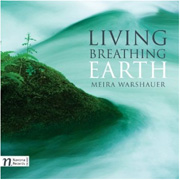By Gigi Yellen-Kohn, JTNews Correspondent
Music by Composer Meira Warshauer: Symphony No. 1, “Living, Breathing Earth” and “Tekeeyah” (A Call)
Moravian Philharmonic Orchestra, Petr Vronsky, conductor
Haim Avitsur, shofar and trombone soloist
Navona Records NV5842. Enhanced format audio CD with additional features.
Textures and rhythms found in nature — bird song, mist, water drops, insect hisses — infuse this exciting symphonic music by a contemporary American composer. Meira Warshauer’s orchestral voice expresses a passion for nature, and also for the musical and liturgical languages of Jewish tradition, in a sophisticated symphonic language native to our time.
As the title implies, “Tekeeyah” features the shofar. It is, in fact, a concerto for shofar, trombone, and orchestra, the first-ever concerto for this combination of instruments, according to the artist’s notes. The New York-based Israeli trombonist Haim Avitsur, soloist on both shofar and trombone, delivers a versatile shofar sound, powerful in the finale, whispery in the opening notes, and pitch perfect over a surprising range.
Warshauer has embedded the ram’s horn into a brash, full orchestra, where its open call extends and expands through other wind instruments. The shofar shares harmonies and textures as a member of the orchestra, in contrast to its better-known liturgical role as the lone voice of a stark wake-up call. The composer has stated that she intends this music as a spiritual wake-up call, too. Jointly commissioned by three orchestras, the Wilmington Symphony, Brevard Philharmonic (both of North Carolina), and the University of South Carolina Symphony, the concerto received its premiere performance in 2009.
Every shofar’s sound is unique. Its range of pitches and the color in its voice depend upon the length, width, and thickness of the horn, as well as on the technique of the person who blows into it. Warschauer has obviously composed “Tekeeyah” with a particular instrument in mind. She has used certain rhythms associated with the shofar’s sound in the synagogue — notably the series of staccato notes called teruah — and built from them whole layers of orchestral rhythms, sometimes with the shofar at the center, but not always. Trombones, French horns, trumpets, and a huge, intense percussion section expand and contract to build this spare, ancient musical idea into a wildly imaginative world of sound.
Rain sticks and tambourines, xylophone and marimba, whispering glissandi from harp and from strings bowed on the “wrong” side of the bridge: All breathe sympathetic support into the concerto’s quieter moments. A listener might catch echoes of Ives or Orff, of Copland or Adams, Bernstein or Samuel Jones in Warshauer’s music. But another listener might have heard none of these composers and, in search of discovery, delight in a thrilling and complex sonic world.
That world opens onto a giant orchestral cicada chorus at the opening of the title work on this album, Warshauer’s Symphony No. 1. The composer has stated that she intends to represent earth in its healthiest state, like a prayer for its health. Indeed, she makes the orchestra into a “living, breathing” body: She has managed to suggest whole hosts of cicadas, to start with, representing an evening music immediately recognizable to anyone who has spent an evening in America’s South.
Warshauer is a native and a resident of North Carolina, raised as a Reform Jew. An award-winning artist, trained at Harvard and at the New England Conservatory of Music, she has produced a wide variety of compositions that have been recorded and performed in North America, Israel, Europe and beyond. A speaker of Hebrew, a Shabbat observer, and a spiritual seeker of the Baby Boom generation, her art reflects an era marked by influences as diverse as Sufism, which she explored early on, and Carlebach, whose music she says brought her to her home tradition. She traces her environmentalism to the first Earth Day in 1970.
As one who loves music, I’m often amused by the sight of fellow Seattle park-walkers hidden under headphones, removed from the audio surprises that lurk in the trees, water and creatures of our shared environment. There’s a true music in that environment. Meira Warshauer has crafted a Jewish musical language that mirrors it.
…
Lovers of classical Jewish music can rejoice as the Milken Archive of American Jewish Music goes digital. Launched in 1990 as an ambitious multi-year CD
project, the venture has evolved into an all-digital information source, now known as “Milken Archive of Jewish Music: the American Experience.” Still located at www.milkenarchive.org, these gatherers of Jewish and American musical traditions have begun to release new material solely via the web, instead of issuing multiple hard copies of music and text. Over these two decades, the Milken Archive has generated 50 CD recordings, historical essays, a radio series, performance notes and biographical research material. It still boasts a vast store of as-yet-unreleased material; the CDs are still available commercially on the Naxos label.
Available for sale track by track, these new editions of the performances formerly released on CD are likely to develop a broader audience for the massive work of this unique Jewish and musical resource center.
The speed of the digital revolution in music-sharing technology, publishing and research has rendered the project’s original goal of releasing more CDs and books pretty much obsolete.
The refreshed website brings it all home this month with the digital release of Volume 2, A Garden Eastward, the volume focusing on Sephardic and Middle Eastern traditions. (Volume 1 is a sampler of the Archive’s offerings.) With so many Seattle Jews who trace their Jewish heritage to Sephardic ancestry, JTNews readers will want to explore these classics. Of special note in A Garden Eastward: The graceful performances by the all-male choir of New York’s Spanish-Portuguese Synagogue, Shearith Israel, where Rabbi Chaim Angel presides, and his father, Seattle native Rabbi Marc Angel, is rabbi emeritus.
Seattle Symphony Conductor Laureate Gerard Schwarz serves on the Milken Archive’s editorial board.
